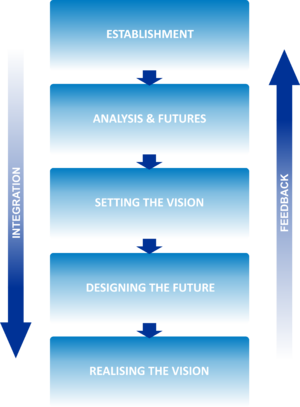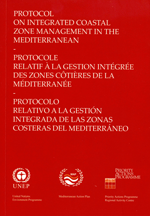The ICZM Process - a Roadmap towards Coastal Sustainability - Introduction
| Introduction |
|
Establishment |
|
Analysis and Futures |
|
Setting the Vision |
|
Designing the Future |
|
Realising the Vision |
|
Welcome to the ICZM Process
Contents
[hide]
The primary target participants in the Integrated Coastal Zone Management (ICZM) Process are the practitioners and partnerships tasked with the implementation of the Process, and in particular those involved in the preparation of ICZM plans, strategies and/or programmes for coastal areas in the Mediterranean and Black Sea. It is also intended that the implementation of the ICZM Process will contribute to a wider discussion on the sustainable development of coastal zones. A unique and groundbreaking international legal instrument - the Protocol to the Barcelona Convention on Integrated Coastal Zone Management, now drives ICZM in the Mediterranean.
The design of the ICZM Process to assist the implementation of the ICZM Protocol is being coordinated by the Priority Actions Programme/Regional Activity Centre (PAP/RAC). in Split, Croatia, and is based on over 30 years of practical ICZM experience in the Mediterranean. PAP/RAC is a component organisation of the Mediterranean Action Plan (MAP), part of the United Nations Environment Programme (UNEP). Twenty-one Mediterranean countries and the European Union are Contracting Parties to the Barcelona Convention, which is being implemented by the MAP. PAP/RAC has built a global reputation for its expertise in ICZM.
In designing the process, PAP/RAC has created synergy between two major ICZM-related projects in the Mediterranean: EU FP7 PEGASO project and the GEF-funded Strategic Partnership in the Mediterranean Large Marine Ecosystem (MedPartnership). Within this latter, PAP/RAC is working closely with the Global Water Partnership (GWP) and UNESCO-IHP to ensure effective integration with river catchment and water basin management, and coastal ground water management.
Structure of the ICZM Process
The ICZM Process is intended to guide, i.e. it is the "how" of ICZM, but it should be adapted, however, to individual local circumstances which will dictate changes to this Process within the overall framework. The ICZM Process is structured into 5 key stages represented in the diagram. The 5 stages are further structured into Key Tasks for each stage.
Just click on the "Establishment" tab or diagram box to start your journey.
Why ICZM?
“Sustainable” is a much used, but rarely defined term. In the case of the Mediterranean, a sustainable coast is one that is:
- Resilient - resilient to future uncertainties of climate change, including rising sea levels, warming and drought; resilient to climate variability such as extreme storms, floods, waves, etc; resilient to earthquakes and erosion; resilient to negative impacts of human processes, including the pressure of tourism and urban development on the coast.
- Productive - productive financially in traditional, modern and future economic sectors; supporting the economic aspirations of the coastal community; providing a competitive asset to the local economy, high in natural and economic values - increasing GDP and alleviating poverty.
- Diverse - ecologically diverse: a rich mosaic of marine and terrestrial ecosystems; diverse rural and urban landscapes, old and new; a diverse economy - providing a diverse, but distinctly Mediterranean experience; a diverse society – providing conditions for a rich mixture of social groups, open to the outside world, etc.
- Distinctive - retaining the cultural distinctiveness of coastal areas, including their architecture, customs and landscapes, recognising the Mediterranean as the “cradle of civilisation” - providing a distinctive marketing image on which to attract investment.
- Attractive - retaining the attractiveness of the coast, not only to visitors but also to investors and local people to promote a self-sustaining cycle of sustainable growth.
- Healthy - free from pollution from land and marine-based sources, with clean fresh and marine waters and the air - providing a healthy environment for people, natural resources such as fisheries, and wildlife.
The above should be used as a checklist to help set up an ICZM plan, strategy or programme. These criteria should be addressed in a balanced way, in a way that maximises mutual benefits and minimises the risk of detrimental consequences.
It is important to note that ICZM encompasses a wide range of issues, each one of them being important in its own merit. Throughout the Process, every sectoral issue that is important in the specific coastal area should be considered. However, in these guidelines not all the issues could be equally treated because it would go well beyond the scope of this endeavour. In order to show how a certain issue should be considered and/or integrated in the ICZM Process we have prepared a draft document which describes how that could be done in the case of climate change, certainly one of the most critical issues many coastal areas are facing today. The findings of that document may be consulted whenever a reader feels compelled to do so.
Expert view - "...keep it simple"
"Coastal issues are complex, but your strategy, your plan or your programme should not be. Just remember that ICZM is as much a social as it is a technical process, and coastal resources will always be limited. So here are a few practical tips to smooth your way:
- Keep it simple and fit for purpose - don’t over complicate;
- Where possible, work with what you have, commission new work/research and data collection only where absolutely required;
- The Process should be adaptive to local circumstances and resources;
- Communication is the key – enabling stakeholders to visualise the problems, potential futures, and to find solutions;
- No ICZM Process should be strictly linear; all stages are iterative and will overlap depending on individual work plans;
- There is no substitute for full stakeholder participation.
And finally - to paraphrase our colleagues in the Global Water Partnership (GWP) - the ICZM Process is designed not just to produce a plan or a strategy for a coastal area. In the end, success or failure of ICZM depends on its ability to catalyse change. This is what matters - not the specific process, nor the form of a strategy or plan document, but whether or not it results in positive action."
Begin your journey here: Establishment
Please note that others may also have edited the contents of this article.
|



